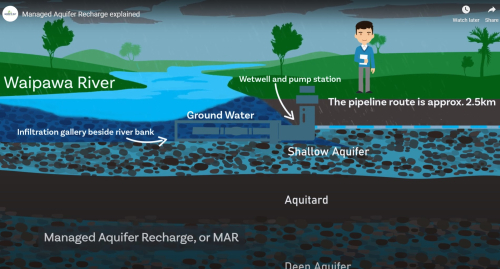I want to...
Current filter: Most popular
A to Z
Apply for a job
Biosecurity
Consents
Consultation
Contact Us
Environmental Data
Farmers Hub
Fix it or Report it
Information Request
Join an Event
Leasehold Land
Meetings
Rates
Water Metering
Have Your Say
Community working together to build Tamatea-Central Hawke’s Bay’s climate change resilience
Published: 29 August 2023

Consent has been granted for a Managed Aquifer Recharge (MAR) pilot in Central Hawke’s Bay, which will see mana whenua, landowners and Hawke’s Bay Regional Council working together to build resilience to the impacts of climate change.
Funded by both the Hawke's Bay Regional Council and Kānoa – Regional Economic Development and Investment Unit, the pilot aims to replenish the Ruataniwha aquifer during the wetter months to ensure sustainable levels are maintained when it’s dry in summer.
The pilot will take high-quality water from the Waipawa River when water levels are higher and pipe it 2km across farmland to a recharge site located in Tikokino. Here water will be delivered to a series of porous ponds and, like the natural recharge process, will soak through the gravels and sediments to recharge the shallow aquifer below. That will supplement nearby springs, streams, rivers and wetlands to help our environment withstand increasingly dry periods.
The pilot will also test adding water to the deeper aquifer, where most of the water we use annually is drawn from.
Hawke’s Bay Regional Council Chair Hinewai Ormsby says getting consent for the pilot is a significant milestone in Regional Council’s programme to address climate change challenges.
“Over the last five years, we’ve seen first-hand how the two extremes of climate change can impact water in Hawke’s Bay - facing two years of severe drought and a devastating cyclone during our wettest year on record.
“We’re nearing the limits of what our waterways can give when it’s dry, and over the long term, we are seeing increasing climate pressures on our water resources. In future, we’ll have even less water than we do now, and NIWA research shows that Tamatea-Central Hawke’s Bay and Heretaunga’s rivers will be some of the most vulnerable to climate change in Aotearoa.” says Chair Ormsby.
“MAR has been used in hundreds of arid regions across the world for over 60 years and this pilot will test whether it’s a tool in our kete to bridge the growing gap between how much water we have and what we need when it’s dry.”
“This consent allows us to proceed with the pilot, however we’ll be balancing when that happens with the wider funding environment we find ourselves in following Cyclone Gabrielle.”
Over the last two-years, the MAR project team has worked closely with marae located near the Waipawa River or whakapapa to the Ruataniwha Aquifer, and landowners of the pilot site on how it will be designed, operated and monitored.
Te Taiwhenua o Tamatea (a confederation of Tamatea-Central Hawkes Bay’s nine marae) Chair Jenny Nelson-Smith, says that the MAR pilot is a unique opportunity for mātauranga Māori and western science to work side-by-side to progress environmental solutions.
“Te Taiwhenua o Tamatea are entering an alliance with the MAR three-year pilot and welcome a Te Tiriti o Waitangi principle-based relationship, working - ‘Kanohi ki te Kanohi, Pakihiwi ki te Pakihiwi – face to face, shoulder to shoulder.”
Ms Nelson-Smith says the relationship reflects the Tamatea whakatauki “Ka whita te ahikaroa o Tamatea Tauhā, whita!” which translates to “The home flames of Tamatea are secured, we are here, we are luminous!”.
Mana whenua will be involved throughout the three-year pilot and lead a cultural monitoring programme.
While the pilot has received support from mana whenua, landowners and the wider community, Chair Ormsby says Regional Council acknowledges there are still reservations about any interventions that put water into our aquifers.
“While we have world-leading MAR scientists heading this project and confidence in the protections in place, we are listening and working through those concerns. This is a limited pilot, with a small impact area. Strict consent conditions will mean only high-quality water will be drawn, filtered and used to recharge the aquifers. The pilot will be the subject of a comprehensive and live monitoring programme to be developed and delivered in partnership with mana whenua.”
Tamatea-Central Hawke’s Bay Mayor, Alex Walker says the district has already felt the devastating impacts of both too much and not enough water.
“All tools to add security to our water ecosystem on the Ruataniwha Plains are warmly welcomed. As a nationally significant concentration of highly productive and fertile soils, the plains are a vital part of the food-producing future of the Hawke’s Bay region,” Mayor Walker says.
For more information on the Managed Aquifer Recharge pilot go to hbrc.govt.nz, search #mar
Head here to check out a video animation on how Managed Aquifer Recharge works.

Disclaimers and Copyright
While every endeavour has been taken by the Hawke's Bay Regional Council to ensure that the information on this website is
accurate and up to date, Hawke's Bay Regional Council shall not be liable for any loss suffered through the use, directly or indirectly, of information on this website. Information contained has been assembled in good faith.
Some of the information available in this site is from the New Zealand Public domain and supplied by relevant
government agencies. Hawke's Bay Regional Council cannot accept any liability for its accuracy or content.
Portions of the information and material on this site, including data, pages, documents, online
graphics and images are protected by copyright, unless specifically notified to the contrary. Externally sourced
information or material is copyright to the respective provider.
© Hawke's Bay Regional Council - www.hbrc.govt.nz / +64 6 835 9200 / info@hbrc.govt.nz


